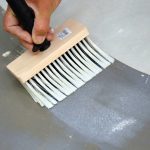Content
- 1 Floor screed
- 2 Warping
- 3 Creak
Installation of a wooden floor seems extremely simple and understandable to people, but there are own nuances that are worth knowing about, and technologies that you need to adhere to. Otherwise, quite serious problems may arise in the future, up to the point that the floor will need to be dismantled and the work performed again.
Floor screed
The floor of the boards has its own technology, which has been honed for a long time.
- First of all, it is worthwhile to engage in the installation of support beams, which are based on the edges of the walls.
- On top of the lag is already worth paving boardwalks.
Some craftsmen say that it is best to join the floorboards as tightly as possible to each other. Of course, this greatly improves the appearance of the floor, the design looks monolithic, and cold air will not appear through the cracks.
But for a long time, experienced carpenters have not laid floorboards close to each other. At the moment, there is still a way to lay the floorboard using staples and wedges, but this approach is advisable in the case of dowel boards. That is, this is such a board, which on the one hand has a special spike, and on the other a groove. If you install the edged board closely, then without fail the owner will encounter problems.





Warping
For work, dried building material should be used. Dry wood has its own advantages, it is light, easy to process and fungus practically does not form. But you should not stack the board close to each other, since there will be no damper clearance, it is compensatory. It should be understood that the tree absorbs moisture well and therefore can expand. That is, when a certain amount of moisture is absorbed, the board can increase in size.


Creak
Often the owner is faced with such a problem, a creak forms when walking. There is also a problem in the fact that during the installation of the board were tightly fitted to each other. And in this case, if a person steps on the board, it bends and a creak appears. That is, under load, the boards rub against each other and make unpleasant sounds.


That is, in the process of work it is worth leaving a damper slot, and in this case the owner will not encounter problems. It is worth noting that such an approach to installation is practiced even in the case of arranging the subfloor when using OSB board or plywood.
-
 The basic rules for creating an alpine hill
The basic rules for creating an alpine hill
-
 Why interior coupes are a bad option for everyday life
Why interior coupes are a bad option for everyday life
-
 How to dissolve the clypeus along its length
How to dissolve the clypeus along its length
-
 Original and roomy bookcase
Original and roomy bookcase
-
 Frequent errors when insulating the front door
Frequent errors when insulating the front door
-
 What primers are not suitable for application under fiberboard
What primers are not suitable for application under fiberboard
-
 How not to regret pouring the bulk floor
How not to regret pouring the bulk floor
-
 How to cheaply connect gas to a cottage
How to cheaply connect gas to a cottage
-
 Why it is important to consider the direction of wallpapering
Why it is important to consider the direction of wallpapering
-
 How to arrange a place for a computer
How to arrange a place for a computer
-
 How to choose a wardrobe in a nursery?
How to choose a wardrobe in a nursery?
-
 What colors are best not to use on the floor: the most impractical options
What colors are best not to use on the floor: the most impractical options
New publications are published daily on our channel in Yandex. Zen
Go to Yandex. Zen


